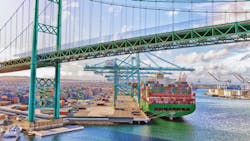Just in time for the holiday season, U.S. port congestion has hit record highs with swarms of containerships sitting idle outside of the Ports of Los Angeles and Long Beach, waiting to unload their cargo. Supply chain snarls have slowed trucking equipment and consumer goods deliveries, a global materials shortage has prompted commercial fleets to alter their truck procurement plans, build rates are down, and nearly two years into the pandemic, we’re still grappling with nationwide labor shortages.
To alleviate some of these challenges before an influx of holiday shopping, President Biden in October called for around-the-clock supply chain operations. Joined by the executive directors of the L.A. and Long Beach ports during a White House summit, Biden announced that after weeks of negotiations the ports would operate 24/7 to help speed up the delivery of goods across America.
Walmart, the nation’s largest brick-and-mortar retailer, committed to moving its products at all hours from the ports to its stores nationwide. FedEx and UPS also committed to significantly increase the amount of goods they are moving at night.
Biden also urged the private sector to step up. “This is not called a ‘supply chain’ for nothing,” he said during that October summit. “This means the terminal operators, railways, trucking companies, shippers, and other retailers as well.”
How, though, is Biden's plan feasible when private and for-hire trucking companies and professional drivers already have stepped up as much as they possibly could with the limited capacity they have? Truck drivers have been working tirelessly to keep the country productive throughout the pandemic, even as COVID-19 forced many drivers off the road or into early retirement. Supply chain bottlenecks and long detention times have interrupted professional truck drivers’ federal hours of service mandates, further exacerbating the problem.
All year, mainstream news reports have highlighted the shortage of truck drivers—a topic typically seen throughout industry reports and trade publications. It’s widely been reported that trucking is experiencing a shortage of some 80,000 drivers. Even before the pandemic struck, estimates from American Trucking Associations had the driver shortage topping 100,000 by 2023 due to projected freight growth, industry retirements, and competition from other industries.
Compounded by a driver capacity problem, the industry doesn’t seem confident that this year’s backlogs will end anytime soon. During an October quarterly earnings call, the leaders of J.B. Hunt Transport Services said they expect supply chain bottlenecks on the West Coast to intensify more into November and December.
Darren Field, president of J.B. Hunt’s intermodal division, told analysts and investors that it’s never been more difficult to attract and retain drivers, adding that rail providers and others are competing for much of the same available talent. The trickiest factor in the labor equation, he said, is at customers’ warehouses, where shortages mean trailers are taking longer to unload and further clogging up the system.
In addition, the industry shouldn’t anticipate a notable drop in demand after the busy holiday season. J.B. Hunt Chief Commercial Officer Shelly Simpson said a number of retailers have told her team they expect shortages of certain products will lead to a bump in the sale of gift cards. That will push more holiday shopping into early 2022 and keep freight lanes full.
Amid all the chaos, the silver lining is market conditions in trucking strongly favor carriers. According to Cass Transportation, semiconductor shortages continue to separate Class 8 tractor production from demand, and trailer supply chain challenges also have limited capacity. Chassis production is still below replacement; however, Cass pointed out, it has improved in recent months and improving chassis turns also are helping to reduce rail network congestion.
And though driver capacity is still generally tight, Bureau of Labor Statistics trucking employment data has improved. Eventually, improving driver and equipment capacity will help rebalance the market, Cass reported, but several recent factors, including Hurricane Ida, the Delta variant, and the chip and chassis shortages have been inflationary for freight rates, extending the cycle at the margin. Vaccine mandates and a closed loophole in the FMCSA Drug & Alcohol Clearinghouse also are expected to challenge driver recovery.
It is now more important than ever for trucking companies to focus on driver safety and celebrate the accomplishments of their essential employees. This industry is thriving, and it’s critical to spread the word that trucking is a lasting and viable career choice for younger generations joining today’s workforce.
About the Author

Cristina Commendatore
Cristina Commendatore is a past FleetOwner editor-in-chief. She wrote for the publication from 2015 to 2023.
